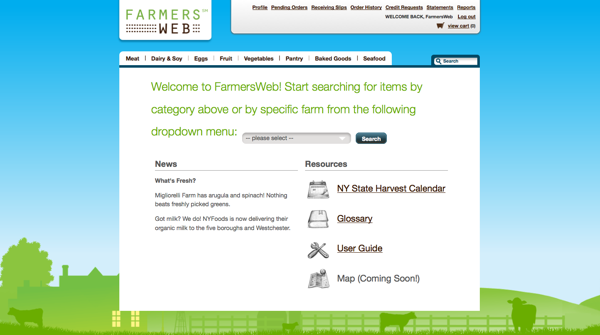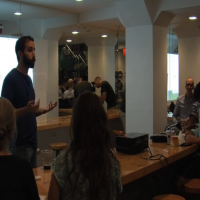More and more restaurants, supermarkets, universities, hospitals, and food service providers are trying to figure out how they can start sourcing more ingredients locally. And while this interest theoretically creates new opportunities to grow local and regional food economies, both farmers and wholesale buyers face a multitude of infrastructural and operational challenges – price, transaction costs, logistics, quality, appearance, food safety, consistency, volume, availability, and knowledge of business, markets, and communications – that must be overcome before local could ever go mainstream.
It is difficult, for example, for wholesale and institutional buyers to find local and mid-sized farms, see what products they have available and place orders. Many of these farms lack websites, and rely on fax, email, and text to distribute their product lists and process orders. Volume and consistency are also major concerns for wholesale buyers, who are often forced to source from numerous farms to get the quantity of food they need. For most, these logistics are simply too inefficient and time consuming.
FarmersWeb, a new wholesale management tool and online marketplace, aims to make it easier for local farms and wholesale buyers to connect. Through their platform, buyers can easily find local farms, see what produce they have available, and order items from multiple farms at once.
“Overall, we’re trying to bring the efficiency and transparency of the Internet to a wholesale process that previously lacked both,” said Jennifer Goggin, co-founder of FarmersWeb. “By creating a tool that makes selling and buying local food easier, we hope to not only boost the local agricultural economy, but also to increase everyone’s ability to eat seasonally and locally, as they shop for food to cook, at work and when they go out to a restaurant for dinner.”
I am always skeptical of startups with business models that rely on farmers regularly updating information through online platforms. The farmers that I’ve spoken with are busy and tend to spend limited time online. Having been burned in the past by other service providers, they can be reluctant to try out new products. Creating a two-sided market is also never an easy feat, particularly when it involves entirely new behaviors for one of the user groups.
That being said, the founding team does have experience with local food distribution logistics. Two of the three co-founders, Goggin and Aaron Grosbard, met while worked at a local food distributor. There they worked with farmers, and learned about distribution logistics for perishable goods, marketing to a high-end restaurant, and back-office management.
I had a chance to catch up with Goggin to learn more about FarmersWeb’s business model.
______________________________
 Danielle Gould: How does FarmersWeb work?
Danielle Gould: How does FarmersWeb work?
Jennifer Goggin: When a farm first signs up, they fill out their profile, delivery settings and inventory list. Once everything is complete, their account is activated, which means buyers can now view the farm’s available products. Buyers can either shop by farm or by category, and they can refine their search by any number of advanced filters. Once the buyer has placed all the items they want into their cart, they choose the desired delivery or pick-up date for each farm, and then check out with a credit card. The farms receive a notification that they have a new order, and they log in to FarmersWeb to confirm it. Each side can view the details of pending and past orders on the site, and print receiving and loading slips for each order. The farm can deliver their products in whatever manner they prefer, whether it’s on their own trucks, by shipping, or by using a third-party logistics provider.
DG: Farmers don’t tend to spend a lot of time online or testing new products. Who is your target market and how are you addressing these challenges?
JG: Our target market is any farm that has access to the Internet and is looking for a way to simplify and expand their wholesale operation. We designed FarmersWeb so that it is incredibly easy to use—there’s really no training necessary, although we always make sure to walk farms through the site when they first register. The minimal time that the farm spends setting up their account on FarmersWeb is returned many times over by the ongoing efficiencies that the website provides by managing their sales operations.
We’ve actually found that the level of ‘tech savviness’ varies wildly. Some of our farmers need to get their younger sons or daughters to manage the site for them; some are asking us if they can use it on their iPad to update their inventory while they’re in the fields (…this feature is coming). And it’s not just a generational thing—some of our most tech-friendly farmers are the ones that have been doing this for decades.
DG: How are you addressing the challenges of building a two-sided marketplace?
JG: While we were developing the website, we gathered a group of pilot users—both farms and buyers—who really liked the concept and were eager to be on the site from its launch. From there, and after we felt confident the website was working as it should, we continued to reach out to individual farms and buyers to slowly build our user base. A number of trade organizations and advocacy groups have been of great help in spreading the word to their members, and many farms and buyers using the site have recommended it to their friends and neighbors. And finally, as much as FarmersWeb is a ‘matchmaker’ of sorts between the two groups, it is also a management tool for farms that already have a roster of current customers. For those farms, it has been much easier for them to say “place your order on FarmersWeb” than to try to manage the process offline.
DG: What is your business model?
JG: We take a commission from the farm on the amount of sales that go through the site, and the commission percentage lowers as the sales go up. There’s no subscription or sign-up fee, so the site is very low risk—if they don’t sell anything, they don’t pay anything. We wanted to encourage farms to use FarmersWeb for all of their wholesale business, not just from the new customers that might find them through the site. Buyers pay the price listed on the website along with any additional delivery fees that the farm may require.
DG: What are the most interesting or unexpected things that you’ve learned so far?
JG: That even the top New York chefs and restaurant groups have been picking up from farmers’ markets if they want local food. We initially expected FarmersWeb to help those wholesale buyers who had not previously been sourcing from local farms. But we quickly discovered the benefits of doing so through an online platform also extend to the buyers who are known for already sourcing locally.
DG: Why did you decide to focus on local vs. regional? How do you define local?
JG: Our definition of local is a maximum of 300 miles between the farm and the buyer—essentially what can be delivered in a day’s drive. However, most of our farms are within 200 miles of the New York City area, which is the only area we are operating in right now. As we expand, we plan to implement a feature that lets the buyer decide what their definition of ‘local’ is and shop accordingly.






